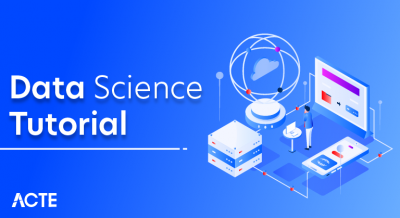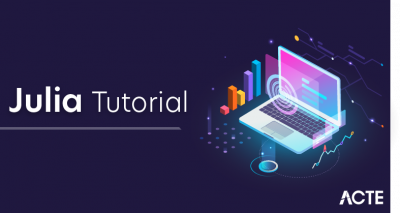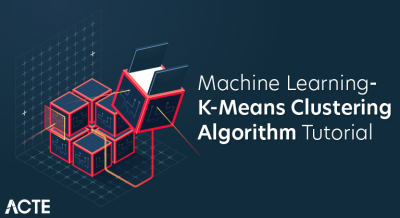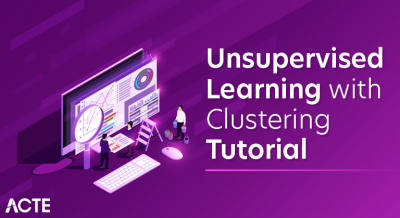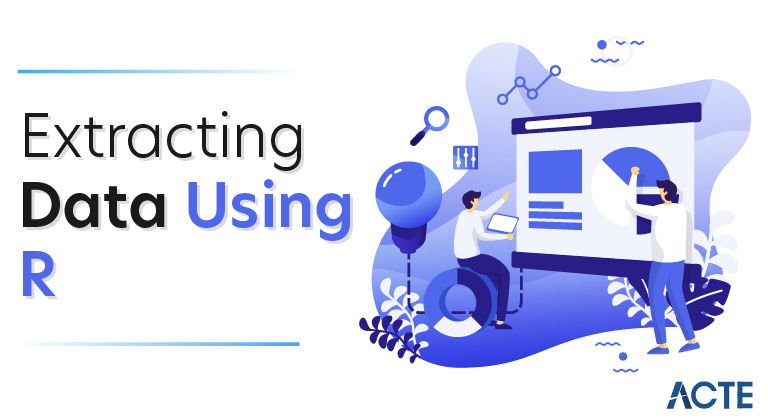
What is R?
Web scraping is an advanced task that not many people perform. Web scraping with R is, certainly, technical and advanced programming. An adequate understanding of R is essential for web scraping in this way. To start with, R is a language for statistical computing and graphics. Statisticians and data miners use R a lot due to its evolving statistical software, and its focus on data analysis.
One reason R is such a favorite among this set of people is the quality of plots which can be worked out, including mathematical symbols and formulae wherever required. R is wonderful because it offers a vast variety of functions and packages that can handle data mining tasks.
rvest, RCrawler etc are R packages used for data collection processes.In this segment, we will see what kinds of tools are required to work with R to carry out web scraping. We will see it through the use case of Amazon website from where we will try to get the product data and store it in JSON form.
The top 3 ways of getting the data you need for price comparison
Feeds from Merchants : As you might be aware, there are several price comparison sites available on the internet. These sites get into a sort of understanding with the businesses wherein they get the data directly from them and which they use for price comparison.
These businesses put into place an API, or utilize FTP to provide the data. Generally, a referral commission is what makes a price comparison site financially viable.
Product feeds from third-party APIs : On the other hand, there are services which offer e-commerce data through an API. When such a service is used, the third party pays for the volume of data.
Web Scraping : Web scraping is one of the most robust and reliable ways of getting web data from the internet. It is increasingly used in price intelligence because it is an efficient way of getting the product data from e-commerce sites. You may not have access to the first and second option. Hence, web scraping can come to your rescue. You can use web scraping to leverage the power of data to arrive at competitive pricing for your business.
Web scraping can be used to get current prices for the current market scenario, and e-commerce more generally. We will use web scraping to get the data from an e-commerce site. In this blog, you will learn how to scrape the names and prices of products from Amazon in all categories, under a particular brand. Extracting data from Amazon periodically can help you keep track of the market trends of pricing and enable you to set your prices accordingly.
1. Web scraping for price comparison
As the market wisdom says, price is everything. The customers make their purchase decisions based on price. They base their understanding of the quality of a product on price. In short, price is what drives the customers and, hence, the market.
Therefore, price comparison sites are in great demand. Customers can easily navigate the whole market by looking at the prices of the same product across the brands. These price comparison websites extract the price of the same product from different sites. Along with price, price comparison websites also scrape data such as the product description, technical specifications, and features. They project the whole gamut of information on a single page in a comparative way.
This answers the question the prospective buyer has asked in their search. Now the prospective buyer can compare the products and their prices, along with information such as features, payment, and shipping options, so that they can identify the best possible deal available. Pricing optimization has its impact on the business in the sense that such techniques can enhance profit margins by 10%.
E-commerce is all about competitive pricing, and it has spread to other business domains as well. Take the case of travel. Now even travel-related websites scrape the price from airline websites in real time to provide the price comparison of different airlines.
The only challenge in this is to update the data in real time and stay up to date every second as prices keep changing on the source sites. Price comparison sites use Cron jobs or at the view time to update the price. However, it will rest upon the configuration of the site owner. This is where this blog can help you — you will be able to work out a scraping script that you can customize to suit your needs. You will be able to extract product feeds, images, price, and all other relevant details regarding a product from a number of different websites. With this, you can create your powerful database for price comparison site.
2. Web scraping in R
Price comparison becomes cumbersome because getting web data is not that easy — there are technologies like HTML, XML, and JSON to distribute the content. So, in order to get the data you need, you must effectively navigate through these different technologies. R can help you access data stored in these technologies. However, it requires a bit of in-depth understanding of R before you get started.
Requirements
In this use case, knowledge of R is essential and I am assuming that you have a basic understanding of R. You should be aware of at least any one R interface, such as RStudio. The base R installation interface is fine. If you are not aware of R and the other associated interfaces, you should go through this tutorial.
Packages:
1. rvest
Hadley Wickham authored the rvest package for web scraping in R. rvest is useful in extracting the information you need from web pages.
Along with this, you also need to install the selectr and ‘xml2’ packages.
Installation steps:
- install.packages(‘selectr’)
- install.packages(‘xml2’)
- install.packages(‘rvest’)
rvest contains the basic web scraping functions, which are quite effective. Using the following functions, we will try to extract the data from web sites.
- read_html(url) : scrape HTML content from a given URL
- html_nodes(): identifies HTML wrappers.
- html_nodes(“.class”): calls node based on CSS class
- html_nodes(“#id”): calls node based on <div> id
- html_nodes(xpath=”xpath”): calls node based on xpath (we’ll cover this later)
- html_attrs(): identifies attributes (useful for debugging)
- html_table(): turns HTML tables into data frames
- html_text(): strips the HTML tags and extracts only the text
2. stringr
stringr comes into play when you think of tasks related to data cleaning and preparation.
There are four essential sets of functions in stringr:
- stringr functions are useful because they enable you to work around the individual characters within the strings in character vectors
- there are whitespace tools which can be used to add, remove, and manipulate whitespace
- there are locale sensitive operations whose operations will differ from locale to locale
- there are pattern matching functions. These functions recognize four parts of pattern description. Regular expressions are the standard one but there are other tools as well
Installation
- install.packages(‘stringr’)
3. jsonlite
What makes the jsonline package useful is that it is a JSON parser/generator which is optimized for the web.
It is vital because it enables an effective mapping between JSON data and the crucial R data types. Using this, we are able to convert between R objects and JSON without loss of type or information, and without the need for any manual data wrangling.
This works really well for interacting with web APIs, or if you want to create ways through which data can travel in and out of R using JSON.
Installation
- install.packages(‘jsonlite’)
Before we jump-start into it, let’s see how it works:
It should be clear at the outset that each website is different, because the coding that goes into a website is different.
Web scraping is the technique of identifying and using these patterns of coding to extract the data you need. Your browser makes the website available to you from HTML. Web scraping is simply about parsing the HTML made available to you from your browser.
Web scraping has a set process that works like this, generally:
- Access a page from R
- Instruct R where to “look” on the page
- Convert data in a usable format within R using the rvest package
Now let’s go to implementation to understand it better.
3. Implementation
Let’s implement it and see how it works. We will scrape the Amazon website for the price comparison of a product called “One Plus 6”, a mobile phone.
Step 1: Loading the packages we need
We need to be in the console, at R command prompt to start the process. Once we are there, we need to load the packages required as shown below:
- #loading the package:> library(xml2)> library(rvest)> library(stringr)
Step 2: Reading the HTML content from Amazon
#Specifying the url for desired website to be scrappedurl <- ‘https://www.amazon.in/OnePlus-Mirror-Black-64GB-Memory/dp/B0756Z43QS?tag=googinhydr18418-21&tag=googinkenshoo-21&ascsubtag=aee9a916-6acd-4409-92ca-3bdbeb549f80’
- #Reading the html content from Amazonwebpage <- read_html(url)
In this code, we read the HTML content from the given URL, and assign that HTML into the webpage variable.
Step 3: Scrape product details from Amazon
Now, as the next step, we will extract the following information from the website:
Title: The title of the product.
Price: The price of the product.
Description: The description of the product.
Rating: The user rating of the product.
Size: The size of the product.
Color: The color of the product.
This screenshot shows how these fields are arranged.
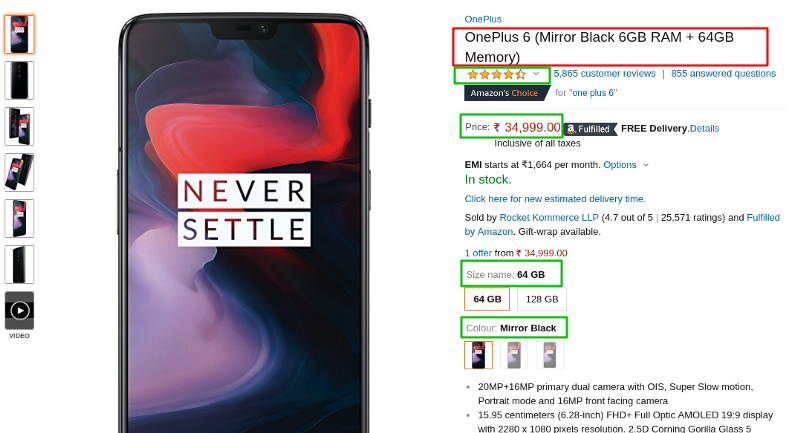
Next, we will make use of HTML tags, like the title of the product and price, for extracting data using Inspect Element.
In order to find out the class of the HTML tag, use the following steps:
- => go to chrome browser => go to this URL => right click => inspect element
Based on CSS selectors such as class and id, we will scrape the data from the HTML. To find the CSS class for the product title, we need to right-click on title and select “Inspect” or “Inspect Element”.
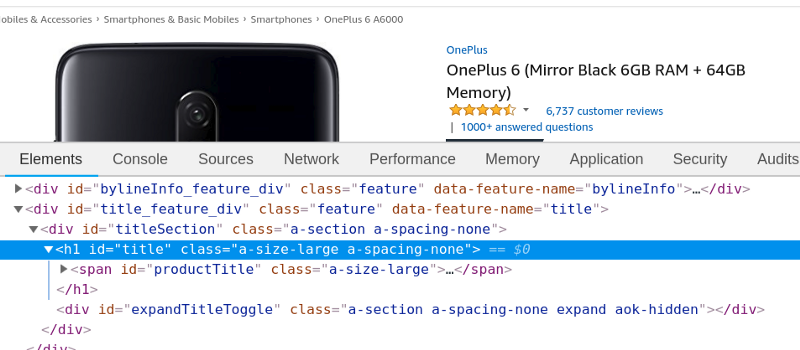
As you can see below, I extracted the title of the product with the help of html_nodes in which I passed the id of the title — h1#title — and webpage which had stored HTML content.
I could also get the title text using html_text and print the text of the title with the help of the head () function.
- #scrape title of the product> title_html <- html_nodes(webpage, ‘h1#title’)> title <- html_text(title_html)> head(title)
The output is shown below:

We could get the title of the product using spaces and \n.
The next step would be to remove spaces and new line with the help of the str_replace_all() function in the stringr library.
- # remove all space and new linesstr_replace_all(title, “[\r\n]” , “”)
Output:

Now we will need to extract the other related information of the product following the same process.
Price of the product:
- # scrape the price of the product> price_html <- html_nodes(webpage, ‘span#priceblock_ourprice’)> price <- html_text(price_html)
- # remove spaces and new line> str_replace_all(title, “[\r\n]” , “”)
- # print price value> head(price)
Output:

Product description:
- # scrape product description> desc_html <- html_nodes(webpage, ‘div#productDescription’)> desc <- html_text(desc_html)
- # replace new lines and spaces> desc <- str_replace_all(desc, “[\r\n\t]” , “”)> desc <- str_trim(desc)> head(desc)
Output:

Rating of the product:
- # scrape product rating > rate_html <- html_nodes(webpage, ‘span#acrPopover’)> rate <- html_text(rate_html)
- # remove spaces and newlines and tabs > rate <- str_replace_all(rate, “[\r\n]” , “”)> rate <- str_trim(rate)
- # print rating of the product> head(rate)
Output:

Size of the product:
- # Scrape size of the product> size_html <- html_nodes(webpage, ‘div#variation_size_name’)> size_html <- html_nodes(size_html, ‘span.selection’)> size <- html_text(size_html)
- # remove tab from text> size <- str_trim(size)
- # Print product size> head(size)
Output:

Color of the product:
- # Scrape product color> color_html <- html_nodes(webpage, ‘div#variation_color_name’)> color_html <- html_nodes(color_html, ‘span.selection’)> color <- html_text(color_html)
- # remove tabs from text> color <- str_trim(color)
- # print product color> head(color)
Output:

Step 4: We have successfully extracted data from all the fields which can be used to compare the product information from another site.
Let’s compile and combine them to work out a dataframe and inspect its structure.
- #Combining all the lists to form a data frameproduct_data <- data.frame(Title = title, Price = price,Description = desc, Rating = rate, Size = size, Color = color)
- #Structure of the data framestr(product_data)
Output:

In this output we can see all the scraped data in the data frames.
Step 5: Store data in JSON format:
As the data is collected, we can carry out different tasks on it such as compare, analyze, and arrive at business insights about it. Based on this data, we can think of training machine learning models over this.
Data would be stored in JSON format for further process.
Follow the given code and get the JSON result.
- # Include ‘jsonlite’ library to convert in JSON form.> library(jsonlite)
- # convert dataframe into JSON format> json_data <- toJSON(product_data)
- # print output> cat(json_data)
In the code above, I have included jsonlite library for using the toJSON() function to convert the dataframe object into JSON form.
At the end of the process, we have stored data in JSON format and printed it.
It is possible to store data in a csv file also or in the database for further processing, if we wish.
Output:

Following this practical example, you can also extract the relevant data for the same from product from https://www.oneplus.in/6 and compare with Amazon to work out the fair value of the product. In the same way, you can use the data to compare it with other websites.
4. End note
As you can see, R can give you great leverage in scraping data from different websites. With this practical illustration of how R can be used, you can now explore it on your own and extract product data from Amazon or any other e-commerce website.
A word of caution for you: certain websites have anti-scraping policies. If you overdo it, you will be blocked and you will begin to see captchas instead of product details. Of course, you can also learn to work your way around the captchas using different services available. However, you do need to understand the legality of scraping data and whatever you are doing with the scraped data.
Advantages of R Programming
Various benefits of R language are mentioned below, which will help you to grasp the concept:
1. Open Source
R is an open-source programming language. This means that anyone can work with R without any need for a license or a fee. Furthermore, you can contribute towards the development of R by customizing its packages, developing new ones and resolving issues.
2. Exemplary Support for Data Wrangling
R provides exemplary support for data wrangling. The packages like dplyr, readr are capable of transforming messy data into a structured form.
3. The Array of Packages
R has a vast array of packages. With over 10,000 packages in the CRAN repository, the number is constantly growing. These packages appeal to all the areas of industry.
4. Quality Plotting and Graphing
R facilitates quality plotting and graphing. The popular libraries like ggplot2 and plotly advocate for aesthetic and visually appealing graphs that set R apart from other programming languages.
5. Highly Compatible
R is highly compatible and can be paired with many other programming languages like C, C++, Java, and Python. It can also be integrated with technologies like Hadoop and various other database management systems as well.
6. Platform Independent
R is a platform-independent language. It is a cross-platform programming language, meaning that it can be run quite easily on Windows, Linux, and Mac.
7. Eye-Catching Reports
With packages like Shiny and Markdown, reporting the results of an analysis is extremely easy with R. You can make reports with the data, plots and R scripts embedded in them. You can even make interactive web apps that allow the user to play with the results and the data.
8. Machine Learning Operations
R provides various facilities for carrying out machine learning operations like classification, regression and also provides features for developing artificial neural networks.
9. Statistics
R is prominently known as the lingua franca of statistics. This is the main reason as to why R is dominant among other programming languages for developing statistical tools.
10. Continuously Growing
R is a constantly evolving programming language. It is a state of the art technology that provides updates whenever any new feature is added.
Disadvantages of R Programming:
1. Weak Origin
R shares its origin with a much older programming language “S”. This means that it’s base package does not have support for dynamic or 3D graphics. With common packages of R like Ggplot2 and Plotly, it is possible to create dynamic, 3D as well as animated graphics.
2. Data Handling
In R, the physical memory stores the objects. This is in contrast to other languages like Python. Furthermore, R utilizes more memory as compared with Python. Also, R requires the entire data in one single place, that is, in the memory. Therefore, it is not an ideal option when dealing with Big Data. However, with data management packages and integration with Hadoop possible, this is easily covered.
3. Basic Security
R lacks basic security. This feature is an essential part of most programming languages like Python. Because of this, there are several restrictions with R as it cannot be embedded into a web-application.
4. Complicated Language
R is not an easy language to learn. It has a steep learning curve. Due to this, people who do not have prior programming experience may find it difficult to learn R.
5. Lesser Speed
R packages and the R programming language is much slower than other languages like MATLAB and Python.
6. Spread Across various Packages
The algorithms in R are spread across different packages. Programmers without prior knowledge of packages may find it difficult to implement algorithms.
Applications of R Programming
These are some more R applications, which you can use to make better decision making:
- R is primarily used for descriptive statistics. Descriptive statistics summarize the main features of the data. R is used for a variety of purposes in summary statistics like central tendency, measurement of variability, finding kurtosis and skewness.
- R is most widely used for exploratory data analysis. R’s most popular package ggplot2 is considered to be one of the best visualization libraries due to its aesthetics and interactivity.
- R is also used for analyzing both discrete and continuous probability distributions. For example, using the ppois() function, you can draw Poisson distribution. Similarly, with the help of dbinom() function, you can plot the binomial distribution.
- R also allows hypothesis testing to validate statistical models.
- You can find a correlation between the variables in R using the lm() function that is used for establishing linear regression as well as multivariable linear regression.
- Using R, you can make use of the tidyverse package that is used for organizing data and data pre-processing.
- R also provides an interactive web application package called RShiny. With this package, you can develop interactive visualizations that can be embedded on your web-pages.
- Moreover, with the help of R, you can develop predictive models that make use of machine learning algorithms to find the occurrences of future events.
- You can integrate R with Hadoop and HDFS file system to process large datasets like social media data quickly and efficiently.
- R is also useful for developing statistical software packages and to implement analytical processing in other software suites.
Real-Life Use Cases of R Language
R applications are not enough until you don’t know how people/companies are using the R programming language.
- Facebook: Facebook uses R to update status and its social network graph. It is also used for predicting colleague interactions with R.
- Ford Motor Company : Ford relies on Hadoop. It also relies on R for statistical analysis as well as carrying out data-driven support for decision making.
- Google: Google uses R to calculate ROI on advertising campaigns and to predict economic activity and also to improve the efficiency of online advertising.
- Foursquare: R is an important stack behind Foursquare’s famed recommendation engine.
- John Deere: Statisticians at John Deere use R for time series modeling and also geospatial analysis in a reliable and reproducible way. The results are then integrated with Excel and SAP.
- Microsoft: Microsoft uses R for the Xbox matchmaking service and also as a statistical engine within the Azure ML framework.
- Mozilla: It is the foundation behind the Firefox web browser and uses R to visualize web activity.
- New York Times : R is used in the news cycle at The New York Times to crunch data and prepare graphics before they go for printing.
- Thomas Cook: Thomas Cook uses R for prediction and also Fuzzy Logic Systems to automate price settings of their last-minute offers.
- National Weather Service: The National Weather Service uses R at its River Forecast Centers. Thus, it is used to generate graphics for flood forecasting.
- Twitter: R is part of Twitter’s Data Science toolbox for sophisticated statistical modeling.
- Trulia: Trulia, the real-estate analysis website uses R for predicting house prices and local crime rates.
- ANZ Bank: ANZ, the fourth largest bank in Australia uses R for its credit risk analysis.


